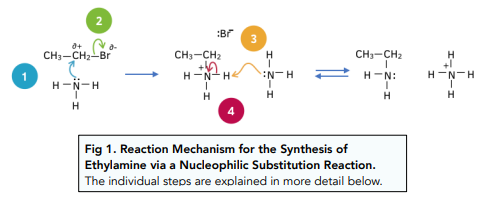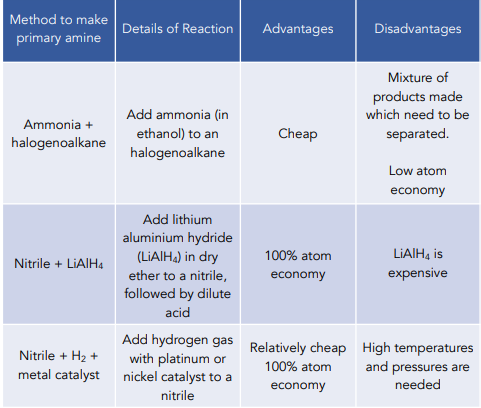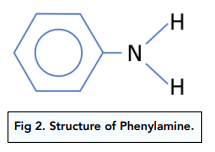Amines - Amine Synthesis (A-Level Chemistry)
Amine Synthesis
Preparation of Aliphatic Amines
There are two main methods of preparing aliphatic amines: via a nucleophilic substitution reaction between a halogenoalkane and ammonia, or via the reduction of a nitrile.
Nucleophilic Substitution Reactions with Halogenoalkanes
- Ammonia is a nucleophile. It has a lone pair of electrons on the N atom.
- The partially charged carbon atom on halogenoalkanes is susceptible to attack by nucleophiles. The halogen atom in the halogenoalkane has a greater electronegativity than the carbon atom it is attached to. This makes the carbon atom more positive and open to attack by nucleophiles.
- Ammonia and halogenoalkanes react to form an amine in a nucleophilic substitution reaction. The ammonia must be dissolved in ethanol for the amine to form.The reaction mechanism for the formation of ethylamine from bromoethane and ammonia shown below can be used as an example.

The steps in the reaction are:
- Ammonia (nucleophile) attacks the halogenoalkane. The lone pair of electrons from the nitrogen atom attacks the slightly positively charged C atom, acting as a nucleophile.
- The halogen is released from the halogenalkane. A bond is formed between the N from ammonia and the C from the bromoethane. This gives the nitrogen atom a fully positive charge. The electron pair in the C-Br bond is subsequently repelled, and the bond is broken.
- A second ammonia molecule enters the reaction. A lone pair of electrons from the N atom of another ammonia molecule attacks one of the H atoms attached to the positive N atom.
- The second ammonia molecule takes a hydrogen from the N-H bond. The N-H bond breaks and a bond between this H atom and the other ammonia molecule forming an ammonium ion. The product is the primary amine ethylamine.
Reduction of a Nitrile
There are two ways of reducing a nitrile to form a primary amine:
- Reducing nitrile using LiALH₄ – The first way to reduce a nitrile is using lithium aluminium tretrahydride (LiAlH₄) in dry ether and then adding dilute acid.

- Reducing Nitrile using Hydrogen + Metal Catalyst – LiAlH₄ is an expensive reactant to use. An alternative method that can be used involves reacting a nitrile with hydrogen gas in the presence of a metal catalyst (e.g. platinum or nickel). High temperature and pressure are needed for this reaction.

Comparing Methods for Making Primary Amines
The nucleophilic substitution method is the cheaper alternative to making primary alkanes.
However, it results in the formation of a mixture of primary, secondary and tertiary amines and quaternary ammonium salts, which must then be separated by distillation.
Using excess ammonia can limit further substitution reactions and maximises the amount of primary amine formed.

Preparation and Uses of Aromatic Amines
Aromatic amines are formed when an amine group is attached to a benzene ring.

This is called phenylamine – it is a primary aromatic amine.
Phenylamines can be synthesised from the reduction of nitrobenzene. The conversion of aromatic nitro compounds to aromatic amines is of huge importance in the manufacture of dyes.
There methods by which nitrobenzene can be reduced: either by using tin and concentrated hydrochloric acid, or hydrogen and a nickel catalyst.
Reduction of nitrobenzene with tin and concentrated hydrochloric acid
1. Heat a mixture of the nitrobenzene, tin metal and concentrated hydrochloric acid under reflux. This produces the ionic salt phenylammonium chloride, C₆H₅NH₃⁺Cl⁻, which is soluble in water.
2. Add a base to the salt to produce phenylamine. Sodium hydroxide is an example of a base that could be used. The resulting phenylamine is an organic molecule, insoluble in water.

Reduction of nitrobenzene with hydrogen and a nickel catalyst
Nitrobenzene is made to react with hydrogen gas in the presence of a metal catalyst (e.g. platinum or nickel). Halogenolkanes
FAQs
Amines are organic compounds that contain nitrogen as a functional group. They are a type of alkaline compound that is derived from ammonia (NH3). Amines have a distinctive odor and are commonly used in a variety of applications, including as solvents, bases, and intermediates in the production of pharmaceuticals and agrochemicals.
Amines can be synthesized through various methods, including reduction of nitriles, alkylation of amides, and nucleophilic substitution reactions. One of the most commonly used methods of amine synthesis is the reaction between an alkyl halide and ammonia (NH3). This reaction produces an alkyl amine, which can then be further reacted to form other amine compounds.
Amines can be classified into three categories: primary amines, secondary amines, and tertiary amines. Primary amines have one alkyl group attached to the nitrogen atom, secondary amines have two alkyl groups attached, and tertiary amines have three alkyl groups attached. The classification of amines is based on the number of alkyl groups attached to the nitrogen atom.
Amines have a nitrogen atom as the functional group, which is surrounded by alkyl or aryl groups. The nitrogen atom has a lone pair of electrons, which makes it a basic compound. The structure of amines can vary depending on the number of alkyl groups attached to the nitrogen atom, as well as the arrangement of these groups.
Amines have several properties that make them useful in a variety of applications. They are soluble in water and have a basic pH, which makes them useful as solvents and bases. Amines also have a distinctive odor and are flammable, which makes them useful as intermediates in the production of fragrances and dyes. Additionally, amines have low boiling points and are relatively reactive, making them useful as intermediates in chemical reactions.
Amines have a wide range of applications in various industries, including pharmaceuticals, agrochemicals, fragrances, and dyes. They are used as solvents, bases, and intermediates in chemical reactions, and are also used as ingredients in the production of pesticides, herbicides, and fungicides. Additionally, amines are used as intermediates in the synthesis of drugs, such as antihistamines, and as intermediates in the production of fragrances, such as perfumes and deodorants.






Still got a question? Leave a comment
Leave a comment